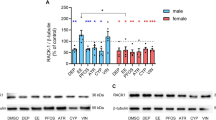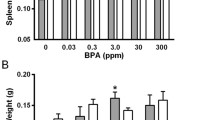Abstract
Androgen-disrupting chemicals (ADCs) can alter male sexual development. Although the effects of ADCs on hormone disruption have been studied, their influence on the immune response is not fully understood. To investigate the effects of ADCs on innate immunity, we tested eight candidate ADCs for their influence on macrophages by measuring nitric oxide (NO) production and cell viability. Our results showed that treatment with a mixture of lipopolysaccharide and hexachlorobenzene increased NO production in RAW 264.7 cells, a murine macrophage cell line. In contrast, compared to exposure to a negative control, exposure to di-2-ethylhexyl adipate (DEHA), benzylbutyl phthalate (BBP), testosterone (TTT), or permethrin decreased NO production. DEHA, BBP, and TTT inhibited NO production in an inducible nitric oxide synthase-dependent manner. Treatment with bisphenol A (BPA), nonylphenol (NNP), or tributyltin chloride (TBTC) reduced NO production and induced cell death. While BPA induced RAW 264.7 cell death through apoptosis, NNP and TBTC caused cell death through necrosis. These results offer insights into the influences of ADCs on the innate immune system.




Similar content being viewed by others
Abbreviations
- ADCs:
-
Androgen-disrupting chemicals
- BPA:
-
Bisphenol A
- BBP:
-
Benzylbutyl phthalate
- DEHA:
-
Di-2-ethylhexyl adipate
- HCB:
-
Hexachlorobenzene
- NNP:
-
Nonylphenol
- PMT:
-
Permethrin
- TTT:
-
Testosterone
- TBTC:
-
Tributyltin chloride
- LPS:
-
Lipopolysaccharide
- NO:
-
Nitric oxide
- iNOS:
-
Inducible nitric oxide synthase
References
Sonnenschein, C., and A.M. Soto. 1998. An updated review of environmental estrogen and androgen mimics and antagonists. Journal of Steroid Biochemistry and Molecular Biology 65(1–6): 143–150. doi:10.1016/S0960-0760(98)00027-2.
Schug, T.T., A. Janesick, B. Blumberg, and J.J. Heindel. 2011. Endocrine disrupting chemicals and disease susceptibility. Journal of Steroid Biochemistry and Molecular Biology 127(3–5): 204–215. doi:10.1016/j.jsbmb.2011.08.007.
Wenzel A, Müller J, Ternes T. 2003. Study on endocrine disrupters in drinking water. Fraunhofer Institute for Molecular Biology and Applied Ecology (IME). ENV.D.1/ETU/2000/0083. http://ec.europa.eu/research/endocrine/pdf/drinking_water_en.pdf.
Damstra, T., S. Barlow, A. Bergman, R. Kavlock, and G. Kraak. 2002. ICPS global assessment of the state of the science of endocrine disruptors. Geneva, Switzerland: World Health Organization, International Programme on Chemical Safety, WHO/PCS/EDC/02.2.
Currás-Collazo, M.C. 2011. Nitric oxide signaling as a common target of organohalogens and other neuroendocrine disruptors. Journal of Toxicology and Environmental Health, Part B 14(5–7): 495–536. doi:10.1080/10937404.2011.578564.
Nakamura, K., and H. Kariyazono. 2010. Influence of endocrine-disrupting chemicals on the immune system. Journal of Health Science 56(4): 361–373.
Flainik, M.F., and L. Du Pasquier. 2004. Evolution of innate and adaptive immunity: can we draw a line? Trends in Immunology 25(12): 640–644. doi:10.1016/J.It.2004.10.001.
MacMicking, J., Q.W. Xie, and C. Nathan. 1997. Nitric oxide and macrophage function. Annual Review of Immunology 15: 323–350. doi:10.1146/annurev.immunol.15.1.323.
Pisetsky, D.S. 2012. The origin and properties of extracellular DNA: From PAMP to DAMP. Clinical Immunology 144(1): 32–40. doi:10.1016/j.clim.2012.04.006.
Martinez, F.O. 2011. Regulators of macrophage activation. European Journal of Immunology 41(6): 1531–1534. doi:10.1002/eji.201141670.
Chen, L.C., J.L. Pace, S.W. Russell, and D.C. Morrison. 1996. Altered regulation of inducible nitric oxide synthase expression in macrophages from senescent mice. Infection and Immunity 64(10): 4288–4298.
Kleinert, H., P.M. Schwarz, and U. Forstermann. 2003. Regulation of the expression of inducible nitric oxide synthase. Biological Chemistry 384(10–11): 1343–1364. doi:10.1515/BC.2003.152.
Hong, C.C., M. Shimomura-Shimizu, M. Muroi, and K.I. Tanamoto. 2004. Effect of endocrine disrupting chemicals on lipopolysaccharide-induced tumor necrosis factor-alpha and nitric oxide production by mouse macrophages. Biological & Pharmaceutical Bulletin 27(7): 1136–1139. doi:10.1248/Bpb.27.1136.
Nakano, K., M. Tsunoda, and N. Konno. 2004. Tributyltin (TBT) increases TNFalpha mRNA expression and induces apoptosis in the murine macrophage cell line in vitro. Environmental Health and Preventive Medicine 9(6): 266–271. doi:10.1007/BF02898141.
Yoshitake, J., K. Kato, D. Yoshioka, Y. Sueishi, T. Sawa, T. Akaike, and T. Yoshimura. 2008. Suppression of NO production and 8-nitroguano sine formation by phenol-containing endocrine-disrupting chemicals in LPS-stimulated macrophages: Involvement of estrogen receptor-dependent or -independent pathways. Nitric Oxide-Biology and Chemistry 18(3): 223–228. doi:10.1016/j.niox.2008.01.003.
Diamanti-Kandarakis, E., J.P. Bourguignon, L.C. Giudice, R. Hauser, G.S. Prins, A.M. Soto, R.T. Zoeller, and A.C. Gore. 2009. Endocrine-disrupting chemicals: an Endocrine Society scientific statement. Endocrine Reviews 30(4): 293–342. doi:10.1210/er.2009-0002.
Kim, S.D., J. Cho, I.S. Kim, B.J. Vanderford, and S.A. Snyder. 2007. Occurrence and removal of pharmaceuticals and endocrine disruptors in South Korean surface, drinking, and waste waters. Water Research 41(5): 1013–1021. doi:10.1016/j.watres.2006.06.034.
Kim, H., Jo, S.-H., Yeon, S.-m., Kim, K., Chung, J., Park, T., Byun, Y., Lee, E., Park, Y., Jung, Y. 2013. Pluronic nanoparticles do not modulate immune responses mounted by macrophages. Macromol Res 1–5. doi:10.1007/s13233-013-1174-7.
Jung, Y.W., R.L. Rutishauser, N.S. Joshi, A.M. Haberman, and S.M. Kaech. 2010. Differential Localization of Effector and Memory CD8 T Cell Subsets in Lymphoid Organs during Acute Viral Infection. Journal of Immunology 185(9): 5315–5325. doi:10.4049/jimmunol.1001948.
Igarashi, A., S. Ohtsu, M. Muroi, and K. Tanamoto. 2006. Effects of possible endocrine disrupting chemicals on bacterial component-induced activation of NF-kappa B. Biological & Pharmaceutical Bulletin 29(10): 2120–2122. doi:10.1248/Bpb.29.2120.
Xie, Q.W., Y. Kashiwabara, and C. Nathan. 1994. Role of transcription factor NF-kappa B/Rel in induction of nitric oxide synthase. Journal of Biological Chemistry 269(7): 4705–4708.
Aderem, A., and D.M. Underhill. 1999. Mechanisms of phagocytosis in macrophages. Annual Review of Immunology 17: 593–623. doi:10.1146/annurev.immunol.17.1.593.
Lai, J.-J., K.-P. Lai, W. Zeng, K.-H. Chuang, S. Altuwaijri, and C. Chang. 2012. Androgen receptor influences on body defense system via modulation of innate and adaptive immune systems: lessons from conditional AR knockout mice. The American Journal of Pathology 181(5): 1504–1512. doi:10.1016/j.ajpath.2012.07.008.
Kanduc, D., A. Mittelman, R. Serpico, E. Sinigaglia, A.A. Sinha, C. Natale, R. Santacroce, M.G. Di Corcia, A. Lucchese, L. Dini, P. Pani, S. Santacroce, S. Simone, R. Bucci, and E. Farber. 2002. Cell death: apoptosis versus necrosis (review). International Journal of Oncology 21(1): 165–170.
Sims, G.P., D.C. Rowe, S.T. Rietdijk, R. Herbst, and A.J. Coyle. 2010. HMGB1 and RAGE in inflammation and cancer. Annual Review of Immunology 28: 367–388. doi:10.1146/annurev.immunol.021908.132603.
Takeuchi, O., and S. Akira. 2010. Pattern recognition receptors and inflammation. Cell 140(6): 805–820. doi:10.1016/j.cell.2010.01.022.
Steinman, R.M., S. Turley, I. Mellman, and K. Inaba. 2000. The induction of tolerance by dendritic cells that have captured apoptotic cells. Journal of Experimental Medicine 191(3): 411–416. doi:10.1084/jem.191.3.411.
Kim, WJ, Yoon, J.H., Kim, S.D., Kim, H.M., Cho, J.C., Kim, B.J., Bae, K.M., Chung, Y.H., Choi, K.H. 2006. Environmental monitoring of endocrine disrupting chemicals. Environmental Exposure Assessment Division, Environmental Health and Safety Department, National Institute of Environment Research, report number: 11-1480523-000129-10.
Acknowledgments
We appreciate Drs. Young-Ho Jeon and Young In Park for their critical comments. We also thank Moon Hwan Oh, Ju Hyung Lee, Sang Hyun Jo, and Hye Young Cho for their technical support. This research was supported by the Basic Science Research Program through the National Research Foundation of Korea (NRF) funded by the Ministry of Education, Science and Technology (2011-0012178), by the BK21 plus program of the Ministry of Education, by the MSIP (Ministry of Science, ICT&Future Planning, 122S-4-3-0434), and by the financial support of Next-Generation BioGreen 21 Program (PJ009508) from the Rural Development Administration, Republic of Korea.
Author information
Authors and Affiliations
Corresponding authors
Additional information
Kyong Hoon Kim and Seung-min Yeon contributed equally.
Rights and permissions
About this article
Cite this article
Kim, K.H., Yeon, Sm., Kim, H.G. et al. Diverse Influences of Androgen-Disrupting Chemicals on Immune Responses Mounted by Macrophages. Inflammation 37, 649–656 (2014). https://doi.org/10.1007/s10753-013-9781-1
Published:
Issue Date:
DOI: https://doi.org/10.1007/s10753-013-9781-1




